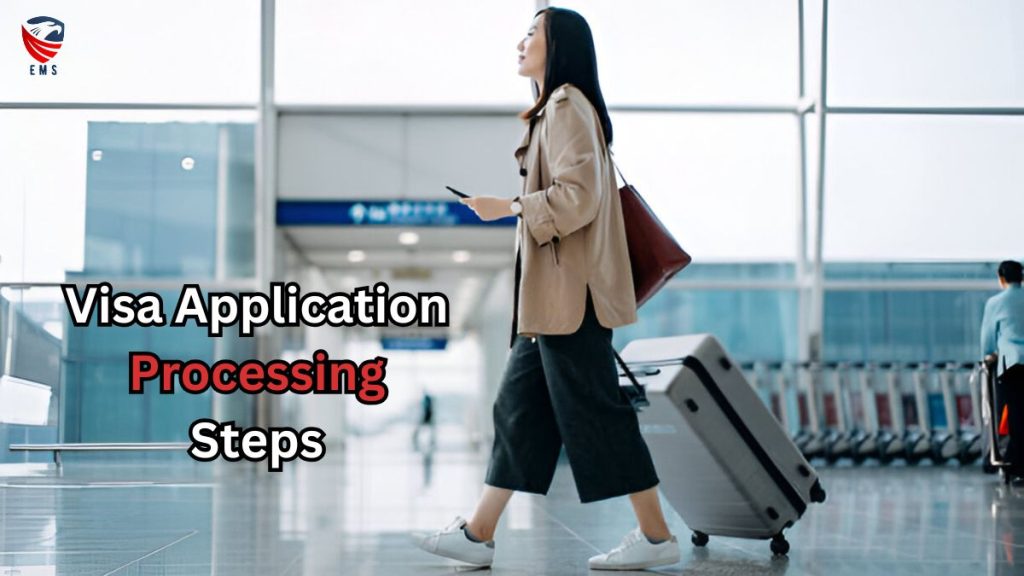Introduction
One crucial step in planning international travel is getting a visa. The visa application processing steps differ by country, but most steps are similar worldwide.
Visa application processing steps
Here are the key visa application processing steps as follows:
Step 1 – Decide the Visa Type
- \Before beginning, identify the kind of visa you require. Common types include tourist, work, student, business, and transit visas customized for different travel purposes. The visa type dictates the specific requirements, fees, and processing times.
- Check the country’s embassy or consulate website to confirm the visa type appropriate for your travel reasons. Some countries give online tools or customer service choices to aid with these options.
Step 2 – Collect Required Documents
- Once you know your visa type another step in visa application processing steps is to gather the required documents. Needed documents usually incorporate:
- A valid passport with a selective number of blank pages.
- A fulfilled visa application form.
- Latest passport-sized photos.
- Financial records, such as bank statements, show your ability to assist yourself during the entire trip.
- Travel itinerary involves flight and accommodation details.
- Invitation letters if visiting for business or family purposes.
- Proof of travel insurance (if required).
- Every embassy or consulate has different document needs, so ensure that you follow their selective guidelines to prevent delays.
Step 3 – Finish the Visa Application Form
- Many visa applications need to be filled out a form, either online or on paper. This form gathers travel dates, personal details, purpose for travel, and sometimes questions relevant to criminal history or past visa refusal.
- Double-check the information before submitting, as even a little mistake can result in procedural delays. Some forms permit electronic submission, while others may be printed and signed by hand.
Step 4 – Schedule an Appointment
- After giving the form, the next step usually incorporates scheduling an appointment at the embassy or consulate. Most countries need in-person visa interviews, specifically for work or study visas.
- Scheduling appointments might incorporate waiting times, so it’s preferable to book as before time as possible, specifically during peak travel seasons. Some embassies even give speedy appointments for urgent travel.
Step 5 – Pay the Application Fee
- Visa application fees differ by country, visa type, and procedure time. The payment can usually be made online, at an appointed bank, or straight at the embassy or consulate. Payment approaches and policies differ, so be sure to confirm the allowable forms of payment.
- Keep the payment receipt as proof of payment, as you might present it during your appointment or to see your application status.
Step 6 – Attend the Visa Interview (if needed)
- For countries that need an in-person interview, this is a significant step in the procedure. During the interview, anticipate questions about your travel plans, financial stability, purpose for visiting, and your intentions to return home.
- Some basic interview tips incorporate dressing professionally, being punctual, and answering questions honestly and positively. This is a chance to convince the visa officer of the legitimacy of your travel reason.
Step 7 – Give Biometrics (if needed)
- Most countries now need biometric data as part of the application. This usually incorporates fingerprints and a digital photograph taken at the embassy or consulate.
- Some countries gather biometrics at particular application centers, making it simpler to submit these without scheduling a distinctive embassy appointment.
Step 8 – Track Your Application
- After giving the application and finishing the interview next in the visa application processing steps most embassies permit applicants to track their application status online. Tracking systems give real-time updates, which can assist in anticipating approval or planning alternative travel arrangements if the procedure is delayed.
- Stay updated, as some embassies may contact you to give add-on documents or to answer further questions.
Step 9 – Wait for Processing
- In visa application processing steps the visa processing times differ majorly by country and visa type. While tourist visas may only take a few days to a few weeks, work or student visas can take numerous weeks or even months. The procedure might be delayed due to security checks, holidays, or a high volume of applications.
- In most cases, you might request an expedited procedure, but add-on fees might apply, and approval isn’t guaranteed.
Step 10 – Get Your Visa Decision
- Once processed, you’ll get an answer. If approved, you’ll be notified to get your passport, generally from the embassy or consulate, or it might be mailed back to you. The visa sticker or stamp inside the passport will have details about your number of entries, permitted stay, and expiration date.
- If disapproved, review the purpose, as some countries permit reapplication or give selective appeal steps. Address the issues raised, and reapply if possible.
Conclusion
Every step of the visa application processing steps carefully—from arranging the documents to managing any needed interviews—can assist ensure a seamless and victorious outcome. So to get all this get in contact with EMS Visa Consultant who are skilled with visa application for family and other visa services.
Being organized and responsive throughout can make the experience more efficient and increase the opportunity for approval.



